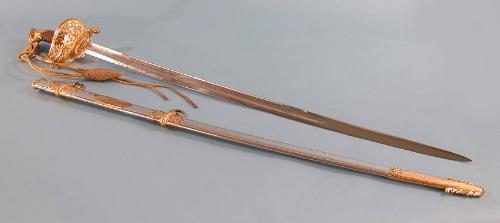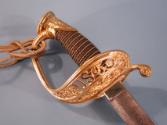Presentation Sword and Scabbard
Original OwnerOriginally owned by
Colonel George Perkins Bissell
(American, 1827 - 1891)
ManufacturerManufactured by
The Collins Company
(American, founded 1826)
Date1862
MediumSteel, brass, shagreen (sharkskin), leather, gold bullion fabric
DimensionsPrimary Dimensions (overall length): 37 1/2in. (95.3cm)
Other (blade length): 32in. (81.3cm)
ClassificationsWeapons
Credit LineGift of the estate of Caroline Bissell Garminy
Object number1951.22.0a-b
DescriptionSingle edged, slightly curved blade with a false edge extending 7 1/2 inches from the point. There are two fullers on the blade, the first fuller is wide and shallow and runs from the ricasso to 7 inches from the point. The second fuller is deep and narrow and runs from 4 inches from the hilt to 8 inches from the point. Both sides of the blade are etched, with the obverse side etched with (top to bottom); Vines surrounding a lined design, war trophies, and eagle sitting on olive branches (sideways along blade) and holding a banner in its beak which says "E / PLURIBUS / UNUM", a banner with "UNION FOREVER" followed by more war trophies and floral designs, with "COLLINS & CO / HARTFORD / CONN." etched at the bottom. The reverse side is etched with (top to bottom); vines surrounding a lined design, war trophies, "Geo. P. Bissel" (in old English) along a large scrolling banner, "U.S." surrounded by ivy, war trophies, more scrolling designs, and on the ricasso is "COLLINS & CO / HARTFORD / CONN / 1862." There is a leather washer between the ricasso and the hilt. The hilt of the sword is cast brass and features a large half basket style pierced guard on the obverse side, decorated in a floral design with the letters "U.S." The reverse side of the guard is slightly turned up, and the quillon terminates at the back of the blade in a scrolling disc finial. The knuckle bow is pierced at the bottom for a sword knot, and connects to the pommel, which is of the Phrygian helmet pattern cast with leaf designs along the outside edges. The sword knot itself is made of a gold bullion rope with an acorn type tassel on the end. The handle is grooved wood wrapped in shagreen (sharkskin), and then wrapped with coiled wire between the grooves. The scabbard is steel with brass bands and carrying rings. Both bands are pierced with scrolling designs at the top and bottom, and have a singular carrying ring on the back side. The tip has a similar design along the sides, with the center being engraved with a liberty pole and cap with war trophies at the base, and the drag is made of a scrolling floral design along each side. Engraved on a gilded plaque between the two bands is "Presented to / Col George P Bissel (in old English) / BY HIS FRIENDS / A tribute to his frank & generous disposition / & his devotion to human rights." Engraved on the scabbard on the reverse side, between the same two bands is "THIS SWORD WAS WORN / BY/ COL. GEO. P. BISSEL. / 25th Reg. CONN. VOLS. / at the Battle of IRISH BEND and through / the campaign of the Teche, La. 1863. / [Illegible] wars, it is dedicated from / [bottom line is completely illegible]." The wooden case that the sword was presented in is inlaid on the top with a brass plate that is engraved "Col. Geo P Bissel. / 25th Regt Conn Vols."
Label TextBefore settling into a career as a Hartford, Connecticut banker, George Bissell led an adventurous seafaring life. In November of 1862, he accepted a colonel’s commission with the 25th Connecticut Volunteers, a unit of nine-months men, and the regiment was forwarded to the Department of the Gulf in Louisiana. He commanded troops throughout the siege of Port Hudson at Irish Ben, Bayou Boeuf, and Brashear City. Colonel Bissell was considered cheerful, kind and generous to a fault. Upon his death in 1891, it was said the officers and men of the 25th Connecticut owed their colonel the collective sum of $10,000.00.
NotesObject Note: According to an inscription on the scabbard, Colonel George Perkins Bissell (1827-1891) wore this sword at the Battle of Irish Bend and through the Campaign of the Teche, in Louisiana in 1863. He was a member of the 25th Regiment of Connecticut Volunteers. (Brundage 4/2/2010)Historical Note: Part of the Union strategy to win the Civil War (1861-1865) was to control the Mississippi River by capturing key cities on the river. This was known as the Teche Campaign; Union generals planned to trap Confederate forces between Bayou Teche and the Atchafalaya River. The Teche Campaign began 11 April 1863 and ended on 20 April.
Brigadier General Cuvier Grover's division went up the Atchafalaya River into Grand Lake, intending to intercept a Confederate retreat from Fort Bisland or turn the enemy's position. On the morning of 13 April 1863, the division landed in the vicinity of Franklin, Louisiana, and scattered the Confederate troops who were trying to prevent them from disembarking. That night, General Grover ordered the division to cross Bayou Teche and prepare for an attack towards Franklin at dawn.
The Battle of Irish Bend, also known as the Battle of Franklin, took place on 14 April 1863. Irish Bend was a bow in the Mississippi River. Confederate Major General Richard Taylor and his men were at Nerson's Woods, around a mile and a half above Franklin. Grover's men encountered Taylor's, and fighting became intense. The Confederate gunboat Diana arrived and anchored the Confederate right flank. The Confederates were outnumbered, however, and were eventually forced to retreat. The victory, along with the one at Fort Bisland two days earlier, assured the success of the Union expedition into Western Louisiana. (Brundage 4/2/2010)
Status
Not on view










